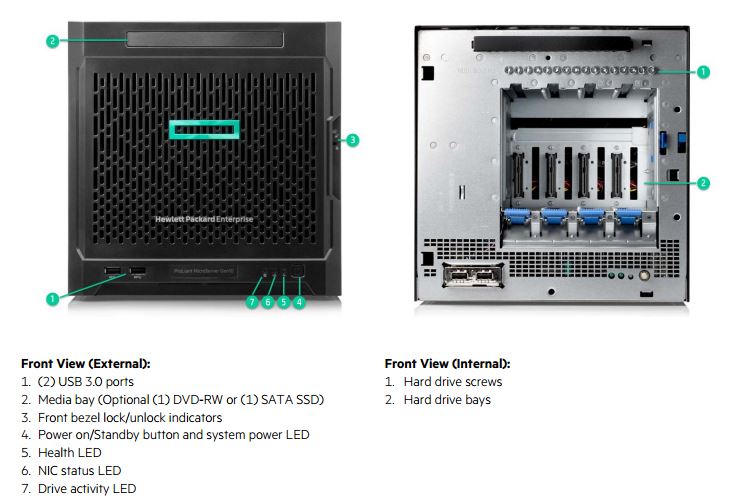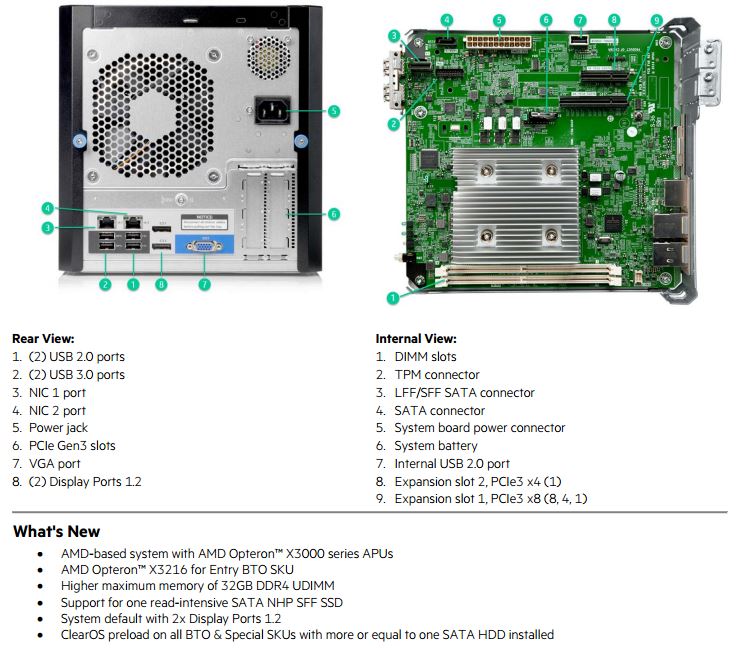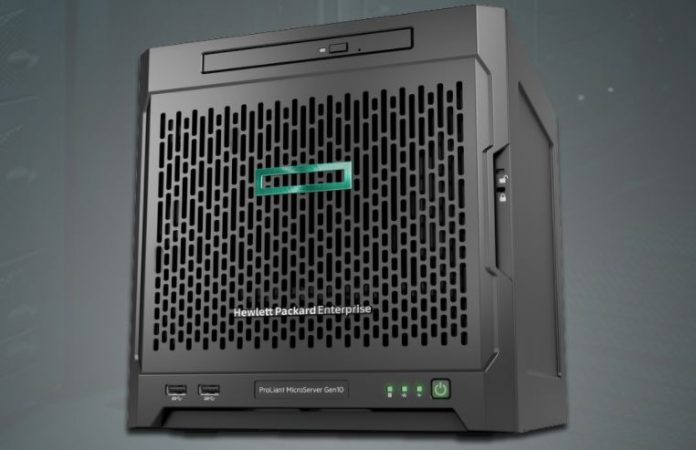The HPE ProLiant MicroServer has been a mainstay of SMB computing and lab environments for years now. STH first broke the HP ProLiant MicroServer Gen8 specs back in 2013, or two site designs and a STH logo ago. HPE often looks to alternative architectures to address special requirements of the SMB/ home office segments with the MicroServer family. The new HPE ProLiant MicroServer Gen10 is no exception featuring AMD Opteron X3000 APUs.
Update 2019-01-28: You can read our full HPE ProLiant MicroServer Gen10 Review for our take on the platform.
New HPE ProLiant MicroServer Gen10 with AMD Opteron X3000 APUs
The AMD Opteron X3000 APUs powering the HPE ProLiant MicroServer Gen10 make a lot of sense in this segment. They combine both x86 cores (no need for ARM compatibility) with AMD Radeon graphics. This is really the next-generation of what we had in the AMD Opteron X2000 series in our HPE Moonshot. The new form factor is a 4x hard drive unit with the same sleek design.

Here are the key specs:
New HPE ProLiant MicroServer Gen10 Key Specs
- SoC: AMD Opteron X3000 series 2 core or 4 core and up to 3.4GHz boost clocks, 1MB or 2MB L2 cache
- SoC TDP: 12-35W
- RAM: Up to 32GB in 2x 16GB DDR4 UDIMM ECC
- Networking: Dual-port Broadcom 5720
- Drive Bays: 4x LFF 3.5″ SATA + Slim Optical or SATA SSD bay
- Low Profile Expansion Slots: 1x PCIe 3.0 x8, 1x PCIe 3.0 x1 (in x4 physical) both with open-ended connectors for up to PCIe x16 installed.
- Warranty: 1 Year
- OS: Barebones or with ClearOS
In terms of specs, the exact GPU details were light but they appear to have a 3rd gen GCN AMD GPU core onboard.

We were a bit surprised to see a server offering in mid-2017 released with only 1GbE network controllers. The trend has been towards faster networking for some time now.
In terms of PCIe expansion, the new MicroServer has limited PCIe lanes available but HPE has certainly seen demand for using larger devices. Both PCIe slots are open-ended allowing for up to PCIe x16 low profile cards to be installed, albeit with reduced bandwidth.
Final Words
This is a big win at a Tier 1 OEM for AMD. The new capabilities of the HPE ProLiant MicroServer Gen10 are certainly appealing. Let us not kid ourselves, the HPE MicroServer is a slick looking machine. It is clear that the integrated GPU is a feature HPE saw a need for over the Intel Atom C3000 series‘ 10GbE networking, PCIe lanes and higher RAM capacities. The two Display Ports on the rear of the unit ensure that the upgraded GPU will be used. Overall, this unit will fall into the “we want one to play with” category.





Interesting. By dropping the ILO and adding two DisplayPorts they are really targeting the media server market, not the typical business user. This is slightly strange for HP Enterprise. I’m not sure I’ll be getting one to replace my Gen8.
Does the Operon X3000 supports AES? Even without an ILO, this would be a nice ZFS build. A PCIe SSD Add-In card as ZIL and an SATA SSD or SATA-DOM instead of the optical drive as L2ARC but mainly it depends on the AES support for encryption
Still can’t beat the N54L – you could fit a 5.25″ to twin 3.5″ adapter into the (full size) optical bay and have six drives – perfect for Raid-Z2. Shame it most likely wont fit in this case – I could do with upgrading my N54Ls.
Pattrick if you could, would, If you have some time, because I have a few questions:
– What happened to gen9 ?
– Are the bays/backplane finally hot swappable ?
Actually, you could fit a 5.25″ to quad 2.5″ into the optical bay, and do better yet with the N54L, but you can easily beat the N54L with the Gen8.
-Get a SchoonDoggy Drive Bracket mod for the Gen8 and fit two 2.5″ 9mm or four 2.5″ 7mm drives inside the server.
-Upgrade the low-power Pentium CPU to a low voltage 2C/4T, 4C/4T or 4C/8T (e.g., Xeon E-3 1265Lv2) processor
-You already have an iLO in the Gen8; the N54L has a remote access card that is pretty much EOL for updates, and you had to buy it separate
-The N54L doesn’t officially support RAID cards; the Gen8 does. A caching hardware RAID card like the HP P222 or P420 integrates with the iLO and works great with Intelligent Provisioning on the Gen8.
-The Gen8 supports 16GB of RAM.
-The Gen8 has USB3. The only thing it doesn’t have is eSATA; better to use a NAS with iSCSI or the P222 controller card (which has an external port that you can couple a storage tower to).
32 GB memory is nice for a microserver, and the main advantage over the Gen8 (especially for ZFS), but it looks more than a little challenging to shoehorn more than 4 drivers in there, which kinda rules out Raid-Z2.
Seems like both the Gen8 and the Gen10 fall just short of being the perfect SOHO FreeNAS server
Can’t believe they have dropped iLO, its now a domestic product and not a business one. I had hoped for more Intel cores, hot swap SATA, an 8 bay 2.5″ option, USB-C and 32Gb RAM. I love the Gen8 boxes for SME and Small scale Virtualisation, this is a big disappointment for me.
IIRC, the reason I didn’t like the previous microserver is that the on-board SATA ports were raid enabled and you could not give ZFS passthrough access to them *unless* you downgraded their speed.
So you either had to downgrade drive speed OR you had to purchase a 9211-8i HBA (and add extra complication and heat inside the chassis).
So I sacrificed fast USB ports and got the FreeNAS mini (which doesn’t have USB3).
My first question about the new gen10 is, how does it allow non-raid passthrough of SATA devices ?
No ilo? It’s a f*cking joke? With no ilo, and no xeon this just a standard pc with different form factor…
Its hard to see where this is aimed at as far as market is concerned. We would love to use it for in mall sign display applications but we would have to dispense a tech for every firmware update and that increases our costs. it might work in a front lobby on premise kiosk application. its definitely aimed at the home market with low performance and low price and no significant enterprise features. ClearOS is a nice tarting point for a Linux server but certainly not a a SMB that is not already a Linux shop. Next step up on the Gen10 ladder is a big one the DL350 or 580, That rules out for small businesses since the performance is over kill and the price is usually out of budget. We are going to continue with the Gen9 ML10 to ML60 jump s a better alternative and use the Gen8 MS for display panels in mall and kiosks.
The form factor is the sticking point for me. The box looks cool, but it would have been better to me if they had made it stackable and more “rackable” in its form – i.e. more “pizza boxy”, more “bladey”, or more “sleddie”. I can think of ways to do this that wouldn’t spoil the standalone appeal, but would make it more practical to get a bunch together.